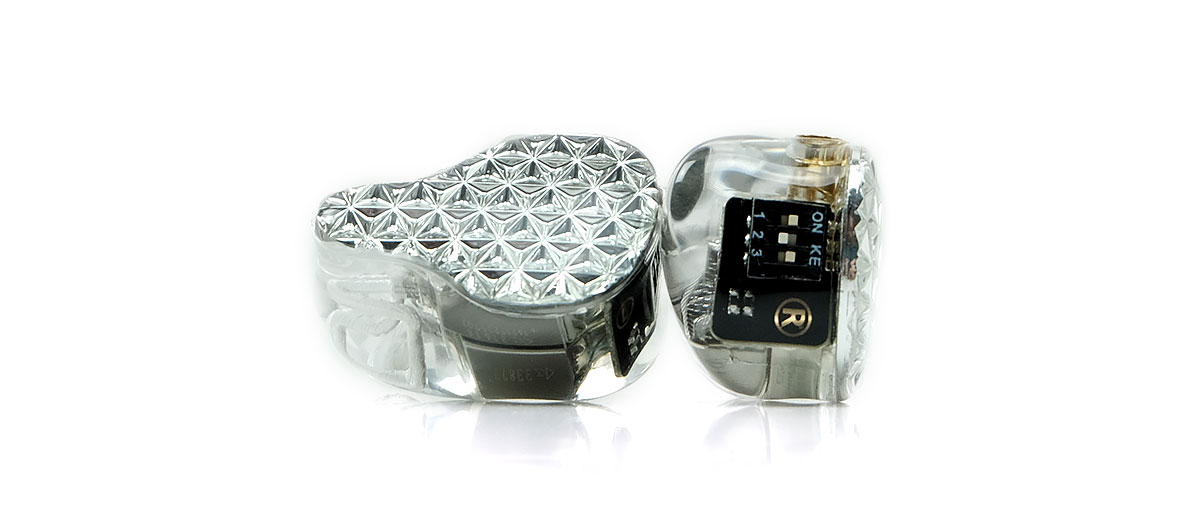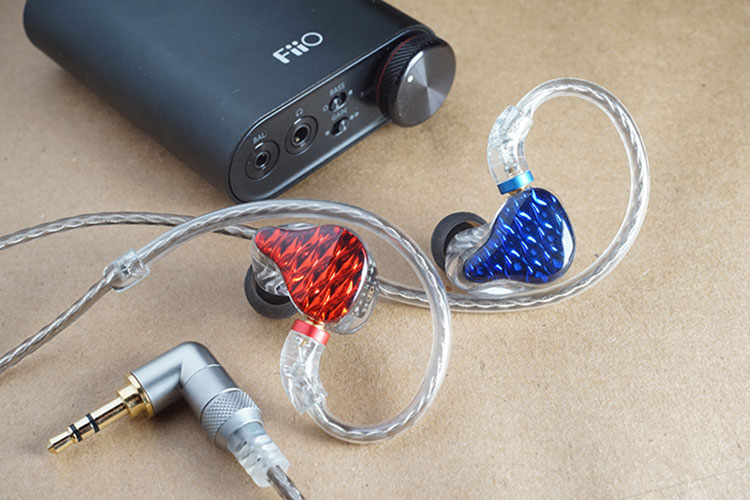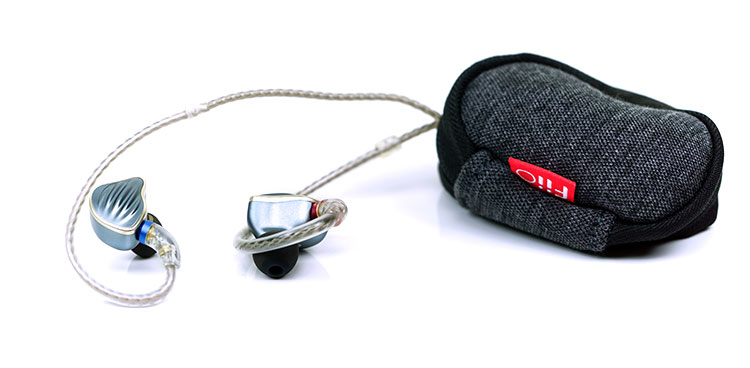Select Comparisons
FiiO FA7
$299.99
Technical
The FA7 is the precursor or the next down from the FA9. It shares a fair number of features but obviously missing some more advanced tech such as the sound switch selector. That means its sound is fixed rather than variable.
While both use an all-BA 4-way crossover design their driver counts and types are different. The FA7 uses FiiO’s previous Knowles partnership drivers, the Knowles CI-22955 woofer, ED-29689 midrange, and a dual BA tweeter SWFK-31736.
The FA9 is all changed with a dual HODVTEC-31618 woofer for the lows, dual EJ33877 for the mids, and a dual SWFK-31736 for the highs. With the impedance switching and new drivers, the impedance values have also changed with the FA7 fixed at 23Ω and 110dB SPL and the FA9 variable from 16-32Ω but with similar SPL levels at 111dB.
Design
Both use a 3D printed process for their designs though the FA9 is much bigger than the FA7. As mentioned, the long tubing inside the FA9 and the additional driver do need additional space.
The aesthetic on the FA9 is also a bit more dazzling with the diamond-cut silver finish whereas the FA7 opts for a slightly simpler design behind a ruby red polished resin finish.
Both come with similar tips selection but the stock LC-3.5B cable on the FA7 is 4-core Monocrystalline SPC as opposed to 8-core LC-3.5C on the FA9. The design of the LC-3.5C FA9 cable is also a bit easier to manage and not quite as stiff as the smaller 4-core FA7 cable.
Performance
There are a couple of important differences and ones which mark out the FA9 as the better all-round performer to the FA7. The first is the level of bass bloom in the FA7 which is higher than the FA9, even with the strong bass switch selection on.
This is combined with a politer treble that injects a little less contrast into the FA7 instrumental and vocal timbre giving it a warm but softer sound.
The FA9 has more of an upper-mids and treble lift, especially with the treble option activated. This delivers a higher level of contrast and reduces the warmth and softness creeping into the midrange performance.
As a result, the FA9 can be as heavy-hitting as the FA7 but sounds cleaner and airier through the mids and treble. The bass response is also tighter which provides more room for vocals and instruments to breathe.
You will be able to pick up on spatial cues a bit better in the FA9’s taller and more open-sounding staging quality. The FA7 is as deep but its softer tone and attenuated treble leave it wanting for more headroom and air as it can sound a bit dense to me.
FiiO FH7
$449
Technical
The FH7 is FiiO’s flagship hybrid monitor and just slightly cheaper than the FA9. I am sort of expecting an FA9 at some point though not sure when.
The FH7 follows a very different aesthetic and internal configuration to the FA7. This is a mixed 5 driver build instead of 6 BA inside the FA9 consisting of a single beryllium-coated 13.6mm dynamic driver for the lows, a single Knowles DFK for the mids, and a dual BA SWFK-31736 for the highs.
FiiO does not specifically mention the crossover in detail for the FH7 so we presume 3 or 4-way much like the FA9. The FH7 also does not have any switch settings for resistance variation or sound tweaking so the ratings are fixed at
The sensitivity rating for the FH7 is on the easy side of the FA9, however, at just 16Ω and 111dB compared to the variable 16-32Ω, 111dB rating of the FA9.
The FH7 sound can be tweaked, however, just not via resistance but instead filters. You get a small pill case of filters that you apply on the nozzle tip that tweak 2 FR bands, treble, and bass as well as a 3rd offering a neutral sound signature. The reference filter is fitted out of the box.
Design
A very different aesthetics and use of materials here. The FH7 components are machined from a CNC aluminum-magnesium alloy as opposed to a 3D-printed resin.
Though slightly smaller, it is tougher and heavier than the FA7. It is also a lot colder in your ear and isolates a bit less due to the bass port vent and well, aluminum is never quite as tight as resin-contoured shells.
The design is a dark “ripple-like” blue ton with gold trimming and a stainless-steel nozzle that runs slightly shorter than the FA9 version. One thing I do like on the FH7 is the extended MMCX stem which is flush on the FA9. I find detaching and attaching the cable a little more assured on the FH7 as a result.
Both have the same tip selection, carry case, and stock SPC 8-core SPC cable so nothing to distinguish either for the accessories and cable.
Performance
Probably the critical differences here focus on the bass timbre and dip into the lower mids of the FA9 combined with the shaping of the upper mids and treble of the FH7.
Dynamic Texture
The FA9 comes across as the warmer of the two with slightly less contrast in the timbre through the mids and treble. The FH7 has some fantastic dynamic bass texture and punches right at the lowest level. The FA7 sounds voluminous but not quite as tight.
You can tell the difference in the air pressure coming at your drums when that dynamic driver hits a sub-bass note. The BA drivers present plenty but in a politer manner whereas the FH7 drives it in. I have to admit the FH7 dynamic driver low-end is the more impressive low-end performer of the two.
BA Driver Changes
Mids into treble has also some significant differences. I find the FH7 has a bit more timbre contrast with a peakier treble overtone.
That enhanced midrange vocal presence in upper harmonic order is slightly emphasized as a result so it will have a ‘crisp’ effect on percussion tone and vocals will seem ‘vivid’.
The FA9’s treble is clean and clear but not quite as dominant in the harmonic balance of its midrange timbre. The vocals still sound very natural to me and overall, I find the tonal balance to be more even-harmonic biased and relaxing.
A bigger lower-mid dip on the FA9 can mean a slight lack of presence or air for some instruments but at the same time, it sounds a little smoother and less prone to sibilance.
For example, a saxophone solo on Rocha’s ‘Lies’ track from their 2017 Unum album sounds different on both monitors. It is forward, and clean with a brighter tone on the FH7 and softer, further back, and warmer on the FA9.
I would suggest keeping the treble boost option on for the FA9 and the bass boost off if you enjoy the FH7 level of contrast but want something slightly more natural through the mids.
FiiO FH5
$269.99
Technical
The FH5 is the second in line on the hybrid side and just behind the FH7. Technically it is a run below the FA7 and FA9. However, a lot of people still love its rich smooth sound and the price point is on the money for me in terms of value to performance.
The FH5 is a 4-driver hybrid monitor consisting of a single 10mm PEK Polymer Nanocomposite dynamic driver and 3 balanced armature drivers. The frequency split is the dynamic driver for the lows, a single larger mid-range BA for the mids, and a dual driver for the lower and upper treble.
The FA9 is a 6-driver all BA creation but all dual drivers with a 4-way crossover, 2 for the lows, 2 for the mids, and 2 for the highs. The drivers in the FH5 are also different, using the older single ED30262 for the mids and a dual driver TWFK-31082 for the highs.
The sensitivity of the FH5 is fixed at 19Ω and 112dB SPL compared to the variable 16-32Ω and 11dB SPL of the FA7. In truth, both are pretty easy to drive and I tend to find north of 112dB SPL is where the noise levels on amp output stages tend to get a lot more noticeable.
Design
Much the same as the FH7, the FH5 is a CNC aluminum-magnesium alloy ‘TRISHELL’ compared to the much lighter 3D printed contoured resin of the FA9. The FA9 seals better due to the lack of a bass venting port and a more ergonomic shape.
The FA9 is bigger but you will notice that in your ear due to the lightweight design. It also has a longer nozzle compared to the FH5 which does help a lot with tip selection. I can seal far better with almost the same tips as the FH5.
The cable on the FH5 is just a step down for me compared to the FA9 cable but given the understandable price point. The FH5 uses a 1.2m mono-crystalline silver-plated braided copper wire with a TPU that makes it a little stiffer and offers less dynamic range than the 8-core LC-3.5C on the FA9.
Performance
On a technical level, from the mids upwards the new FA9 BA drivers really outperform the FH5 triple configuration in terms of dynamic range and resolution. The FH5 sound beyond the 2k marker can lack a little presence and though the tuning is not peaky it can sound brittle in comparison.
The FA9’s mids are smoother, and more refined, and when the low-end is not pumping out wave after wave of EDM energy it also sounds way more complex or holographic compared to the FH5.
The low-end, on the other hand, is very much a driver trade-off. You get more warmth, possibly more quantity also, and more mid-bass bloom with the FA9 BA drivers, even with the bass boost off.
However, the FH5 dynamic driver still has better extension and power, and a shade less bloom also. The ‘verve’ I tend to find in good dynamic drivers shines through very nicely.
One thing to note, like the FH7, the FH5 has much more of a 1-3 bump whereas the FA9 is gentler and very reserved in the 3-4k region. That does affect timbre which is more rounded and not as forward on the FA9.
I tend to go with treble boost and bass off to maximize the upper mids’ presence and headroom as much as I can on the FA9.
With the FH5 you get some treble presence but it is more lower-treble focused and slightly faded in comparison. You will also perceive less upper treble extension compared to the FA9 when that treble boost is turned on.
Our Verdict
The FA9 is an impressive upgrade on the FA7, no doubt about that. It still has some legacy traits with that warmish sound but everything is now tighter, more extended or airier, and definitely more resolving.
The low-end is big for a BA driver though I have to say, I still have a preference for their hybrid dynamic driver tuning from the FH7.
The switching technology is some required value-add. It takes the question of whether or not the FA9 suits me or not to which sound I like the most.
I have always said that options that create choice make for a more nuanced preference selection rather than a take-or-leave-it scenario. There is power in choice and for me, the FA9 synergy potential is now much better than before.
I am curious though if the switch can be applied to their hybrid range which would be something. I am also very aware that mathematics is infinite thus 9 can be 11 and 11 can be 13.
The FA9 is not going to be the end game for FiiO by my reckoning. The improvements with the FA9, however, are excellent.
FiiO FA9 Specifications
- Impedance: 16-32Ω @ 1kHz
- Frequency Response 15Hz – 40kHz
- Sensitivity: 111 dB/mW
- Cable: 1.2m interchangeable 3.5mm MMCX cable






